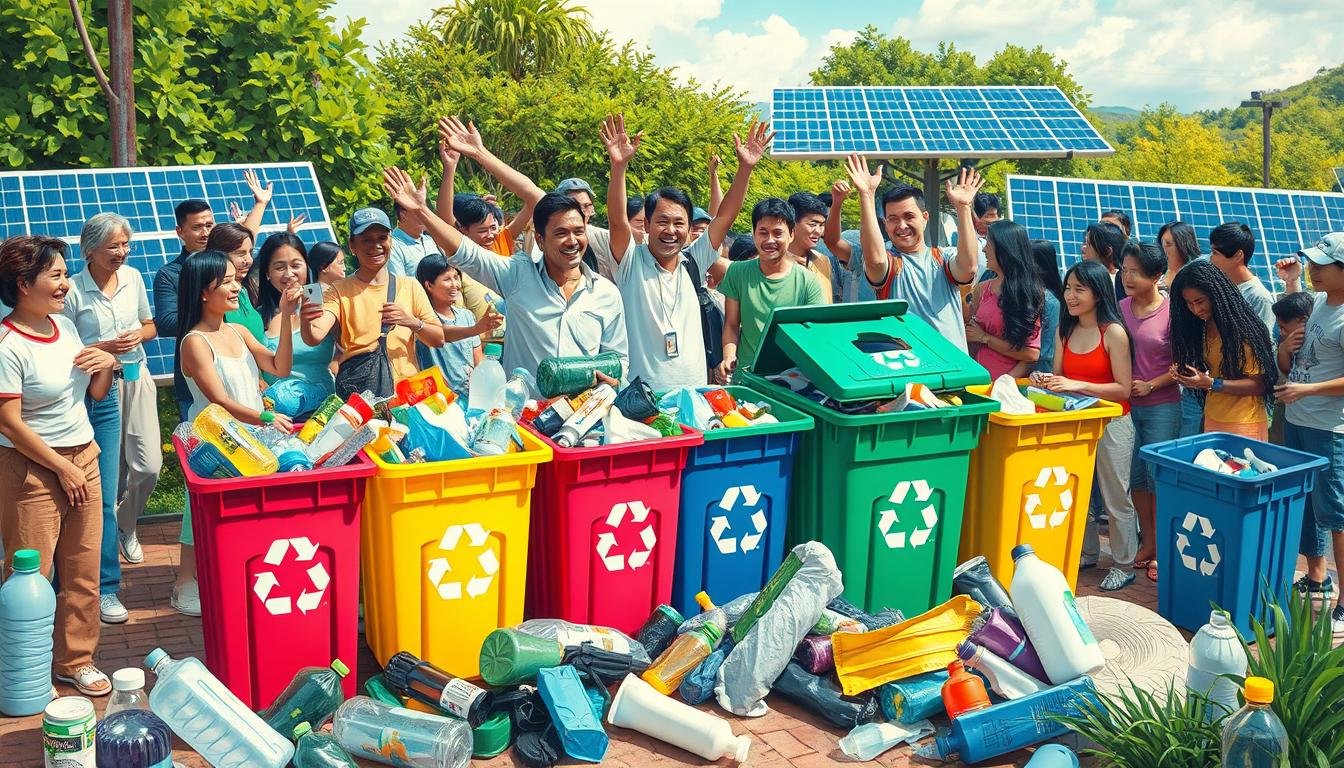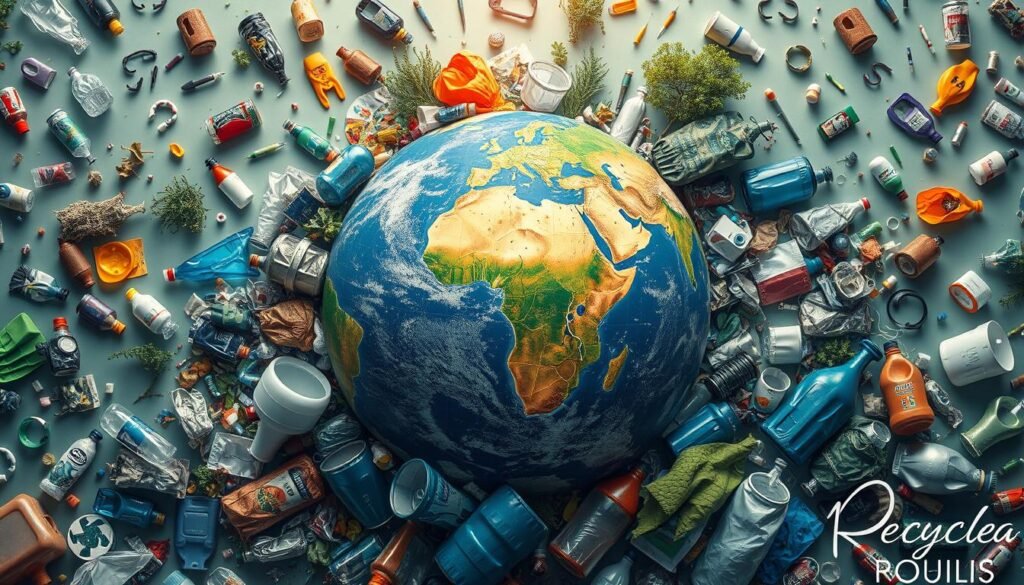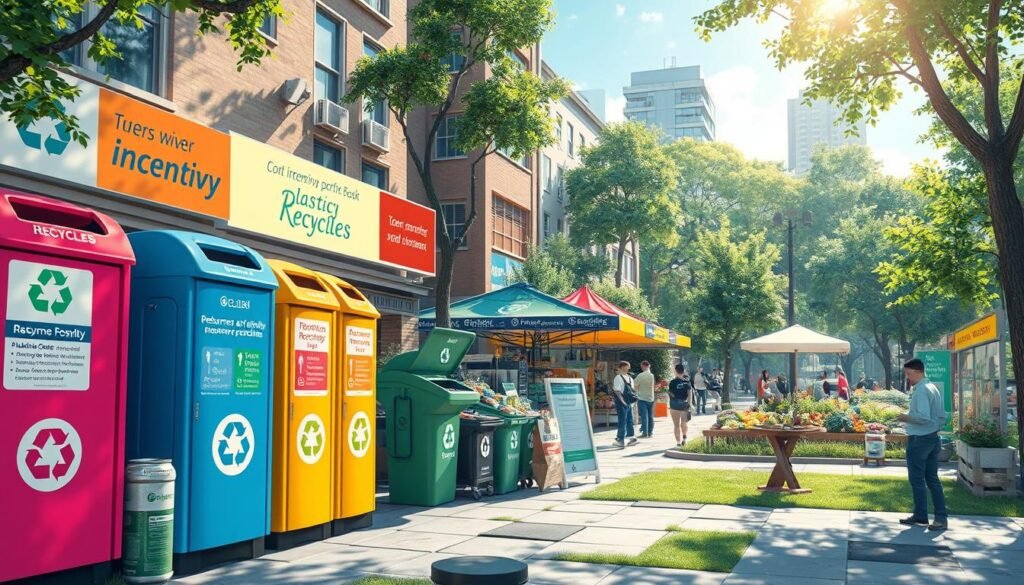Внесите некоторые изменения в окружающую среду
-
Здание 3, Wanyang Innovation City, улица Langxia, город Юйяо, провинция Чжэцзян

Изучение потребительских стимулов для переработки пластика
Are we doing enough to turn the tide against plastic pollution, or are we missing out on simple, effective incentives that could make a real difference?
Как сокращение пластиковых отходов becomes increasingly crucial, examining the role of recycling incentives is vital. The global production of plastics reached a staggering 360 million tonnes in 2018, yet only 14% of plastic packaging is collected for recycling annually1. With the alarming projection of plastics potentially outnumbering fish in our oceans by 2050, we must take swift action to implement sustainable consumer practices. Annually, 5 to 13 million tons of plastics invade our oceans, wreaking havoc on marine life and causing an estimated USD 8 billion in global damage to marine environments1. In Europe alone, around 25.8 million tons of plastic waste are generated, with less than 30% collected for recycling1.
Plastic waste is not only an environmental menace; it also presents significant economic challenges. Countries are losing millions in unrecycled packaging materials and missing out on the potential job creation through enhanced recycling initiatives. For instance, Finland boasts a packaging recovery rate of 114.6%, while Belgium leads with an 85.3% recycling rate1. By 2025, Europe aims to increase its plastic recycling target from 22.5% to 55%1. Such statistics illustrate the merits of effective recycling strategies and the necessity for consumer incentives to encourage sustainable practices.
Основные выводы
- Global plastic production was 360 million tonnes in 2018, with just 14% of plastic packaging recycled1.
- Annual marine plastic pollution ranges from 5 to 13 million tons, causing billions in damages1.
- Only 30% of plastic waste in Europe is currently recycled; the target is to reach 55% by 20251.
- Finland and Belgium lead in packaging recovery and recycling rates, respectively1.
- Economic benefits include reducing unrecycled packaging material loss and creating jobs through recycling initiatives1.
The Importance of Plastic Recycling
Plastic recycling is paramount for mitigating the severe consequences of inadequate утилизация пластиковых отходов. As global plastic waste production is projected to nearly triple by 2060, it becomes imperative to focus on effective утилизация пластиковых отходов strategies. Unfortunately, about half of this waste will end up in landfills, with less than a fifth being recycled2.
Воздействие на окружающую среду
One of the critical environmental impacts of mismanaged plastic waste is ocean pollution, which threatens marine life and ecosystems. Plastics make up a significant portion of marine debris, leading to substantial biodiversity losses and disruptions in marine ecosystems. For instance, Germany leads the world in plastic recycling due to its advanced sorting systems and comprehensive recycling policies2. By improving утилизация пластиковых отходов, we can contribute significantly to экологическая устойчивость.
Экономические выгоды
Economically, the efficient recycling of plastics can reclaim substantial material value that would otherwise be lost. Implementing Container Redemption Value (CRV) programs for plastic bottles could lead to a recycling rate three times higher compared to non-deposit counterparts2. California’s initiative to include CRV on plastic, wine, and spirits bottles demonstrates the substantial экономический эффект от переработки отходов, with potential nationwide benefits through federal policies2. Additionally, adopting a minimum of 30% post-consumer recycled (PCR) content in plastic production can accelerate collection processes and enhance recycling initiatives2.
Sustainability Goals
Aligning with sustainability goals involves reducing plastic production and enhancing recycling rates globally. Collaborative efforts on a global scale are essential for sharing best practices and technologies to effectively manage plastic waste. Financial incentives for using recycled materials can boost the incorporation of recycled plastics in manufacturing processes2. The government funding research into new recycling technologies and sustainable materials is also crucial to tackling the plastic waste issue, further ensuring the экономический эффект от переработки отходов and promoting экологическая устойчивость2.
Current State of Plastic Recycling
Understanding the current state of plastic recycling requires a closer look at global recycling rates, проблемы утилизациии opportunities in recycling. The disparity in global recycling rates illustrates the range of successes and failures in different regions. For example, in 2018, the United States recycled only 8.7% of its plastics, with 15.8% incinerated with energy recovery, and a significant 75.6% sent to landfills3. This contrasts sharply with countries that have implemented successful extended producer responsibility policies, leading to higher recycling rates3.
Global Statistics
The packaging sector, constituting 44.8% of plastic usage, is the largest contributor to plastic waste3. Buildings and construction follow at 18.8%3. Additionally, plastic waste made up 12.2% of municipal solid waste in the U.S. in 20183. Despite efforts, only 64% of material recycling facilities in the U.S. are privately owned, indicating a need for more public investment to enhance recycling infrastructure3.

Challenges and Opportunities
Recyclers face multiple проблемы утилизации, including economic hurdles where producing plastic from recycled material is more expensive than using virgin materials3. In 2018, recycled PET garnered a value of $309 per ton, while recycled HDPE had a value of $729 per ton, significantly lower than the $1,432 per ton for recycled aluminum4. Furthermore, technological limitations, such as the contamination caused by plastic shopping bags, hinder automatic sorting and recycling efficiency4.
Conversely, numerous opportunities in recycling can be tapped into. For instance, introducing advanced recycling technologies that utilize pyrolysis could lead to infinitely recyclable plastics, substantially widening the market for plastic waste4. Additionally, deposit refund systems (DRSs) have proven successful in states that implement them, with PET bottle recycling rates of 55.7% compared to 16.1% in states without such systems4. Policies that reward recycling and link costs to manufacturers are also demonstrated to boost recycling efforts significantly3.
Effective policy initiatives and technological innovations represent promising pathways to enhance the overall effectiveness and economic viability of plastic recycling, addressing both current проблемы утилизации and capitalizing on existing opportunities in recycling.
Types of Consumer Incentives for Plastic Recycling
Incentivizing consumers to engage in plastic recycling can be achieved through a variety of approaches. Different incentive programs cater to diverse consumer behavior patterns, encouraging more sustainable practices.
Financial Incentives
Financial incentives, such as deposit return schemes, have proven to be particularly effective. For example, Finland’s deposit return system led to a 94% recycling rate for aluminum cans and 92% for plastic bottles in 20205. Norway, with an environmental tax on bottle producers, achieved a remarkable 97% recycling rate5. Additionally, 88% of consumers prefer cash rewards as recycling incentives, even if the amount is low5. Such measures clearly demonstrate their potential impact on increasing recycling rates.
Product Discounts
Another powerful incentive is offering product discounts. This approach not only provides immediate savings to consumers but also fosters a positive brand image. Retailers engaged in such practices can avoid losing up to 15% of their customers who prioritize bottle deposit and return opportunities5. For instance, Pret A Manger’s discount strategy rewards customers with reduced prices, creating a win-win situation for both parties. Furthermore, platforms like OneStep Financial enable automated rule-based reward distributions, making the process seamless for both retailers and consumers5.

Civic Rewards
Civic rewards, including community benefits and recognition programs, play a significant role in promoting recycling rewards. The incentive scheme in Southern England demonstrates this effectiveness, with 11,000 households joining the program, reducing 1,000 tonnes of residual waste and saving GBP 90,0006. Additionally, the GREEN$ smart card introduced in Hong Kong in 2020 for recycling facilities has further propelled participation7. Rewarding recyclers with access to sports facilities and leisure activities not only enhances community engagement but also fosters long-term commitment to recycling efforts.
Case Studies on Effective Consumer Incentives
Examining specific case studies on plastic recycling incentives reveals innovative corporate recycling strategies that successfully boost participation rates. These initiatives exemplify how effective recycling incentives can be both strategic and practical in encouraging sustainability.

Just Eat’s Nudge Theory Approach
Just Eat leveraged Nudge Theory to encourage consumers to opt-out of receiving unnecessary plastic utensils with their food deliveries. This approach does not force change but gently influences behavior by making the eco-friendly choice the default option. This method has proven effective in reducing plastic consumption and waste disposal.
Pret A Manger’s Discount Strategy
Pret A Manger implemented a discount strategy that doubled the previous discounts for customers who used reusable cups. This financial incentive resulted in a significant increase in the use of reusable cups, drastically reducing single-use plastic waste. This approach showcases how financial effective recycling incentives can drive substantial changes in consumer habits and support corporate recycling strategies.
PepsiCo’s “All In On Recycling” Initiative
PepsiCo’s “All In On Recycling” initiative is a large-scale effort aimed at enhancing recycling rates through extensive investments in infrastructure and consumer education. By integrating educational campaigns with financial incentives, PepsiCo aims to achieve a scalable model that can be implemented globally to improve recycling participation rates. This initiative underlines the importance of substantial corporate investments in promoting recycling practices.
For further details on successful incentive programs, you can explore plastic recycling incentive programs that offer both monetary and non-monetary rewards to different communities.
Behavioral Economics and Plastic Recycling
Incorporating behavioral economics into plastic recycling strategies can profoundly affect consumer behavior modification. By understanding the psychological factors that drive decision-making, we can effectively nudge individuals towards more sustainable practices.
Nudge Theory Explained
Nudge theory in recycling relies on subtle prompts to encourage environmentally friendly actions without restricting freedom of choice. For instance, behavioral economics shows that simple changes like making recycling bins more accessible can significantly increase usage rates. By facilitating easier recycling processes, we can influence consumer behavior and reduce plastic waste.
Implementing Behavioral Changes
Numerous studies highlight the effectiveness of behavioral interventions in reducing plastic waste. Only 5% (2.4 million tons) of the estimated 51 million tons of plastic waste produced in the United States in 2021 was actually recycled8. This stark figure demonstrates a critical need for change. We can leverage commitment-making strategies, such as pledges to recycle, to target habits and enhance recycling behaviors. Researchers suggest using social and financial rewards to lower plastic usage and to emphasize the impacts of plastic pollution through educational campaigns. This holistic approach ensures a significant shift in consumer behavior modification8.
We must combine individual actions with corporate and government efforts to effectively reduce single-use plastics and promote a circular plastic economy. For example, the need for commitment from all stakeholders is underlined by the fact that about 40% of all plastic waste is generated from single-use plastics, like straws, bags, and food containers8. Additionally, moral norms, subjective norms, and perceived behavioral control have significant impacts on residents’ behavior intention for plastic recycling, emphasizing the multifaceted nature of the issue9.
To illustrate, Dhaka’s density of 47,400 people/km², with a rapidly growing population predicted to exceed 25 million by 2030, presents a severe challenge for waste management efforts. Without behavioral change interventions, plastic waste is predicted to overwhelm these efforts globally by 20309. Therefore, the implementation of effective nudge theory strategies in urban areas is crucial.
Practical solutions involve ensuring access to plastic-free options, such as bans on single-use items and incentives for using reusable alternatives. By examining cases where these interventions have been successfully applied, we can develop robust strategies that harness the power of behavioral economics to achieve our recycling goals.
It is imperative to acknowledge that recycling behaviors extend beyond initial actions. Post-purchase behavior, such as reusing plastic items, holds significant environmental benefits and is key to reducing overall plastic waste8. For comprehensive change, we must integrate initiatives that address every stage of the consumer cycle, maximally leveraging nudge theory in recycling to reinforce sustainable practices.
For further insight into the importance of behavioral change interventions, refer to Professors Kaitlin Raimi, Heather Barnes Truelove, and Amanda R. Carrico’s arguments, emphasizing that recycling alone is insufficient, and that reducing plastic demand is essential. Their work advocates for corporate and governmental collaboration to develop a circular plastic economy. Explore their full arguments здесь10.
Raising Consumer Awareness of Recycling
In raising awareness about recycling, it is crucial to educate consumers on how and why they should participate. Обучение переработке отходов is pivotal in creating a culture of sustainability, ensuring that individuals understand the significant impact of their actions on the environment. By incorporating effective educational campaigns, businesses and governments can inform the public about the benefits and procedures of recycling.
Образовательные кампании
Educational campaigns are designed to clarify the recycling process, emphasizing the environmental and economic benefits of recycling. For instance, understanding that over 12 billion metric tonnes of plastic waste are projected to end up in landfills by 2050 can motivate consumers to adopt better recycling habits11. Moreover, campaigns that highlight the average lifespan of plastic products and their long decomposition times, up to 500 years in some cases, can encourage individuals to reduce their plastic use11. When more consumers are aware of recycling symbols and labels, they influence businesses to innovate and invest in recycling infrastructure11.
Corporate Social Responsibility Initiatives
Corporate social responsibility (CSR) initiatives play a critical role in promoting recycling and sustainability. By integrating CSR in recycling into their business models, companies can inspire both internal and external stakeholders. Such initiatives not only address environmental goals but also respond to the growing demand for sustainable packaging techniques from informed consumers11. However, it is essential for companies to avoid greenwashing, as this can undermine consumer confidence and the recognition of genuine sustainability efforts11.
Using Social Media for Awareness
Social media campaigns have become powerful tools for spreading recycling awareness. Platforms like Facebook, Instagram, and Twitter allow companies and organizations to reach a wide audience quickly and effectively. By sharing compelling content, such as infographics, statistics, and success stories, they can significantly increase engagement and participation rates in recycling programs. For example, consumers who learn from social media about the annual production of over 430 million tonnes of plastic are more likely to support and participate in recycling efforts12. Additionally, showcasing eco-friendly alternatives to plastic, such as bamboo products and glass containers, can encourage sustainable consumer behaviors12.
Overall, through обучение переработке отходов, CSR in recycling, and impactful social media campaigns, we can enhance public awareness and foster a more sustainable future.
Consumer Incentives for Plastic Recycling
Implementing consumer incentives for plastic recycling involves a blend of effective strategies and recognizing the long-term benefits for the environment. By making recycling more convenient and accessible, along with offering financial benefits, we can drive greater participation among consumers.
Effective Strategies
Several effective strategies can motivate consumers to participate in recycling programs:
- Offering discounts, cashback, and special gifts to encourage sustainability efforts has proven successful, as seen in various regions investing in plastic recycling systems and machinery to manage high disposal costs and penalties13.
- Increasing the availability and labeling of sustainably packaged products can drive higher consumer purchases, with 35-36% of respondents indicating they would buy additional sustainably packaged products if they were more available in stores14.
- Enhancing public awareness campaigns can significantly impact recycling participation, evidenced by the improvement in public awareness of plastic pollution in Thai society13.
Long-term Benefits
Сайт long-term environmental benefits of sustained consumer participation in recycling are substantial. These benefits include:
- Reduction in landfill waste: As consumers engage in recycling strategies, we can significantly decrease the volume of waste that ends up in landfills.
- Decreased pollution levels: Companies investing in EPS recycling systems in Japan have seen reductions in pollution due to fewer instances of illegal dumping13. This improvement mirrors broader efforts to incorporate more recycled content in packaging, with postconsumer recycled content in plastic packaging targeted to reach 30% by weight in the United States by 202514.
- Conservation of natural resources: By using materials like recycled PET, HDPE, and PP in manufacturing, energy consumption can be reduced by at least 79%, and greenhouse gas emissions can be cut by at least 67%14.
We believe a holistic approach—combining policy measures, corporate action, and individual responsibility—is essential to achieving significant improvements in recycling outcomes. The transition to more eco-friendly packaging does present challenges, such as higher costs and design requirements13, but the advantages of these sustainable incentives и long-term environmental benefits make the effort worthwhile.
| Strategy | Воздействие |
|---|---|
| Discounts and cashback | Encourages consumer participation in recycling13 |
| Improved labeling | Increases purchase of sustainably packaged products14 |
| Public awareness campaigns | Boosts general awareness and participation in recycling13 |
Заключение
As we reflect on the diverse aspects of plastic recycling discussed throughout this article, one thing becomes clear: effective consumer incentives are vital for enhancing recycling outcomes. From the significant insights into environmental impacts to sustainable economic benefits, the urgent need to address plastic waste with a comprehensive action plan is undeniable.
Our analysis revealed that 33% of consumers recycled more due to incentives provided by local authorities, highlighting the potential of strategic policy implementation in driving sustainable practices15. Moreover, the integration of advanced technologies, such as AI-driven sorting systems and chemical recycling, indicates promising avenues for overcoming existing challenges in the recycling ecosystem16. This underscores the importance of continued innovation and policy refinement to foster a будущее устойчивого развития пластика.
The collaborative effort required cannot be overstated. Governments, corporations, and individuals must work in unison, leveraging educational campaigns, corporate social responsibility initiatives, and social media to raise awareness and engage communities. With 42% of recyclers receiving payment for their efforts, it’s evident that financial incentives remain a strong motivator for participation15. By implementing and refining these strategies, we can make substantial progress towards a sustainable, circular economy that benefits us all.



